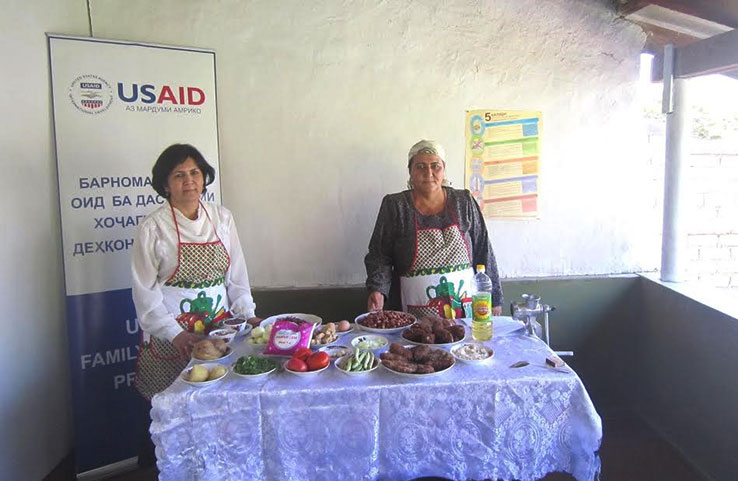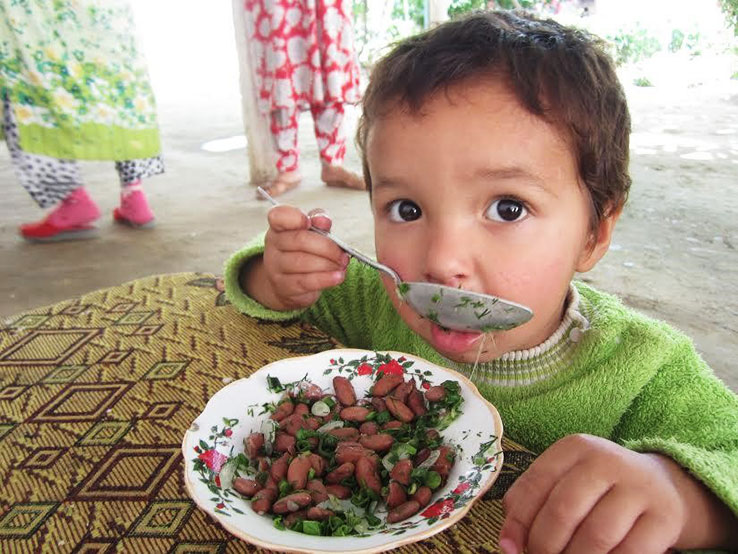By Shanna Ridenour and Sayora Khalimova, USAID Tajikistan
Nestled in the mountains of Central Asia, Tajikistan is the poorest country in the region. While agriculture accounts for over 50 percent of employment, only about seven percent of Tajikistan’s land is suitable for farming due to its mountainous topography. The old irrigation systems in this landlocked country are not adequate to meet the needs of its arid climate, which complicates agricultural growth. These factors make access to fresh fruits and vegetables very difficult, which causes many women and children to be undernourished. In fact, one in four children under the age of five is affected by stunting, the highest rate in Central Asia.1
Yet there is tremendous opportunity for improving nutrition in the country. From late 2010 to early 2015, USAID’s Family Farming Project, funded by Feed the Future, the U.S. Government’s global hunger and food security initiative, sought to address these issues in Tajikistan by promoting agricultural growth and improved nutrition, particularly for women and children. A byproduct of these efforts was the development and production of a healthy cookbook in the local Tajik language that sought to give parents culturally-sensitive and nutritious recipes for their children. The recipes included five new and 12 existing dishes, many of which feature nutritious beans, that are good for children under the age of five and pregnant and lactating women.
To choose and develop the recipes for the cookbook, project staff surveyed communities to determine which foods were available in markets and household gardens. They then tested recipes in various households to make sure they were accessible, affordable, and, of course, tasty. Once the cookbook was approved and printed, staff distributed copies to the Tajikistan Institute of Health, primary health care providers, schools, and other USAID partners working in nutrition and health, including other projects under Feed the Future. Two of the cookbook’s recipes, kidney bean cutlets and a bean and beet salad, were named Best Overall in Feed the Future’s 2016 recipe contest.

Khursheda Isaeva, pictured above on the left, is a local pediatrician whose team led the way in developing this cookbook. “The kidney bean cutlets were the basis for the recipe book. Kidney beans are mainly composed of carbs and fiber but are also a good source of protein, plus they are rich in various vitamins and minerals,” she says. This recipe also took a fairly common ingredient in Tajik cooking (the kidney bean) and turned it into a great alternative to meat when making cutlets. It was this kind of innovative recipe that made the cookbook a success in the community.

The Feed the Future Tajikistan Agriculture and Water Activity continues the Family Farming Project’s work in promoting agriculture-led growth and improved nutrition in Khatlon province, an area that suffers from high levels of poverty and malnutrition. One crop the project works on to help address smallholder production and nutritional issues is mung beans. They are high in potassium, fiber, magnesium, and vitamins B and C, and most importantly, grow best in warm, dry climates. Mung beans also serve as a great alternative protein source, which is especially important in Khatlon where animal-source protein is often too expensive for many people. Additionally, one serving of mung beans provides the entire recommended daily intake of folate, which is essential for preventing early births, neural tube defects, and even miscarriages. The activity has planted 17 demonstration plots of mung beans where farmers can come and learn best practices in farming and harvesting this new crop. They then take their knowledge and apply it to their own land plots and gardens.
Similarly, the priority of the Feed the Future Tajikistan Health and Nutrition Activity is to improve the health and nutrition of communities within Khatlon through community-based trainings. While much of this training is generic — washing produce, dietary diversity, and basic hygiene — some information is crop-specific, such as the nutritional value of mung beans. This important information is disseminated through a network of community health educators, a group of nearly 1,400 volunteers — about 95 percent are women — that are trained by the activity to teach their neighbors all about healthy food and healthy behaviors. These volunteers cumulatively host as many as 18,000 training sessions per month on various topics — including beans!
Even though beans are small, they have incredible potential to help lead the way in Feed the Future’s efforts in Tajikistan in helping families live healthier lives through research, new crops, and community-led education. This fall, Feed the Future celebrated one of the most versatile foods around and its shared progress in the fight against hunger, poverty and malnutrition. By participating, we hope to share the story of how humble crops like beans are helping women and children in developing countries grow stronger.
